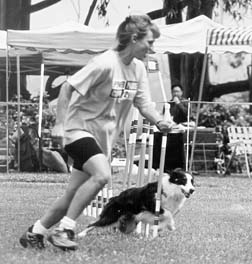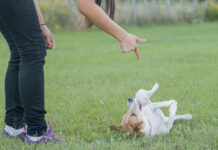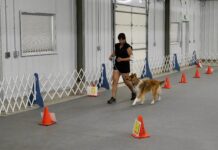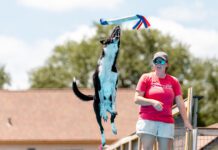[Updated February 5, 2019]
Whether you and your dog are road-seasoned competitors in canine sports, just “playing around” in novice dog shows, or simply striving to train your dog to stop embarrassing you in public, you can improve your mutual performance and your relationship by learning and practicing basic sports psychology techniques.
When we work with our dogs, we communicate our wishes to them largely through our body language, posture, facial expressions, and tone of voice.

Stress can vastly alter how our “messages” come across to our dogs. When we are nervous about going into the show ring or anxious about passing another leashed dog on the sidewalk, we are likely to inadvertently “tell” our dogs all sorts of things that we really don’t mean to or want to, such as, “Oh my God this is scary!” or “I feel like I’m going to be sick!”
Sports psychology techniques teach us how to get our brains and bodies under control, so our physical language exudes a relaxed confidence – which is enormously relaxing and confidence-boosting to our dogs, who operate best when they know they can trust a competent leader.
If I do say so myself, I’m sort of a “poster child” for the benefits of sports psychology, since I was absolutely stuck at a certain level of competence at agility with my two Border Terriers.
Sport Psychology for Dogs: What Brought Me Here
For me, it’s hard to imagine anything more fun than a weekend of dog agility competition with my agility partner, Dash. And, from watching the enthusiastic competitors at herding trials, obedience trials, flyball events, tracking exercises, freestyle performances, and other types of dog sports, I think most participants would agree with me about their chosen sports.
It’s also difficult to imagine an undertaking more holistic than dog sports such as agility. The effective combination of mind, body, and emotion, in the dog and handler individually and as a member of the team, holds the key to success. All elements are connected and interrelated to achieve peak performance.
Dash, my five-year-old Border Terrier and three-year agility competitor, and I earned the novice and intermediate qualifications necessary to propel us into competition at the highest levels of difficulty. Remember that line about being careful what you wish for?
Joking aside, as an aware and responsible handler, I created a regimen of training and healthcare to support the demands of high-level competition. I feed Dash a homemade, fresh food diet and augment her food with nutritional and herbal supplements that promote joint health, heart health, and strengthen her immune system.
Dash also receives regular chiropractic adjustments to prevent injury, and enjoys a superficial massage from me after competitions. These modalities increase the flow of blood and energy throughout her system after taxing it by jumping, turning, and racing through the agility courses. I combine training, resting, and fun in a mix that keeps her motivated but not tired.
Personally, I focus on eating and resting well, and shed a few pounds to make running the courses easier. In essence, I put together a well-thought-out plan to support our athletic endeavors.
When Progress Stops, Seek Outside Assistance
As new entrants into advanced levels of competition, we struggled with the issues of courses more difficult to navigate and faster time requirements, and our progress stalled. I made embarrassing mistakes at trials and Dash became frustrated with our clumsy runs. We qualified occasionally, but disappointment and frustration were settling in.
I wasn’t sure what piece of the holistic puzzle we were suddenly missing, so I began to carefully watch the top competitors at each trial and try to figure it out. Advanced agility competition presents only the slightest chance of redeeming a run after making even a small mistake of any kind. So I knew that competitors who qualified consistently were not just good at making up for errors made during a run. They were just plain good.
One of the first things I noticed about these top competitors was that their dogs were not faster than Dash at her best and the handlers themselves were not quicker than me when I ran in good form.
As I got to know some of my fellow competitors, I discovered that many had limited access to agility practice equipment and did not receive regular lessons from national level instructors. They had to juggle work, family, and travel, and some wore knee braces, had bad backs, or suffered from weak ankles or sore hips. Several were significantly older than me, and I have to look backward to see 50. Some of their dogs were rescued from abusive homes, so their intense agility preparation program as puppies was nonexistent.
My hopes of identifying any sort of “disadvantaged circumstances” as the root cause of our slow progress quickly vanished!
The Key to Dog Sport Success
The next thing I noticed was that these highly successful competitors were more poised, more focused, and more relaxed than most competitors. They rarely complained about the course, the weather, the footing, the judge, or whether Mercury was retrograde. And they spent more time interacting with their dogs than socializing with the other competitors at the trials.
I began to suspect that they had mastered the art of sports psychology, or tapping into the power of programming their minds to reach their highest potential of performance and to capture that level of performance from their dogs. By observing and talking with these competitors, and reading about the new concepts of sports psychology, a missing piece of the holistic puzzle for Dash and me has gradually taken shape.
Programming Dogs for Success
Agility enthusiasts are embracing the sport psychology techniques presented in books like the one written by Jane Savoie, an award-winning equestrian competitor. In That Winning Feeling, Savoie explains how the subconscious mind cannot distinguish between the real and the imagined. The subconscious mind reacts to information provided by the conscious mind and attempts to accommodate what the conscious mind sets forth as a goal or as reality, whether positive or negative.
For instance, my unconsciously controlled fear responses, like tight muscles and dilated pupils, kick in when I watch a horror movie, even though my conscious mind knows it’s not real. But the biochemical responses my body produces, as a reaction to my feelings of fear, are very real, and they cascade into a corresponding physical response that can impact my behavior and performance.
After viewing the movie, I probably will be much more hesitant to enter a dark room alone for a couple of days. And, if entering dark rooms alone is required in my life, I have just degraded my performance by induging in the negative imaging in the movie.
Savoie suggests that when we carry negative images of a particular activity (like a poor agility run) in our conscious mind, our unconscious mind believes those images to be reality, or a real goal of the conscious mind. The belief of the unconscious mind can provide desired or undesired cascades into conscious behavior.
Savoie also states that achieving peak performance results from mastering acquired skills, not from relying on genetic gifts. She believes that persistence, not talent, lies at the root of competitive athletic success.
Top competitors have learned to use the power of positive imaging and other precepts of sports psychology to their advantage in the agility ring and in many other competitive dog sports. Let’s take a look at some of their proven techniques:
• Banish negative visual images. One fellow agility competitor refuses to wear any of the popular, humorous agility T-shirts that read “Double Q Challenged” (Double Q refers to qualifying in both a regular and a jumpers-with-weaves run on the same day in an American Kennel Club agility trial) or “My Dog Needs a Faster Handler.” Her T-shirts read “Agility: an Army of Two” or “Agility: Fun on the Run” or, my favorite, “Agility Forever, Housework Whenever.” Don’t you get different feelings about agility just by reading each of these phrases?
• Banish negative verbal input. A national level agility competitor often walks the course carrying a CD player and wearing headphones. I asked him if he was listening to motivational messages. He replied that the CD player was empty. He uses the headphones to block out all of the negative conversation that takes place among competitors while they are walking the course. He doesn’t want to overhear folks talking about it being a course that favors big dogs, or requires unfair maneuvers, or has a particular “crash and burn” zone. He wants to focus on the challenges of the course and prepare his handling strategy.
This competitor also eliminates all negative words and phrases from his agility vocabulary. He replaces works like “try” and “hope” and “if” with “when” and “will.” He no longer “hopes to win if he’s lucky” but instead “he and his dog will do their best and put winning well within reach.” His agility “challenges” are defined by others as agility “problems.”
I have come to think of my course handling challenges as agility “obstacles” that I need to negotiate just like the A-frame and the weave poles are agility obstacles that Dash has to negotiate. And I remind myself to do so with the enthusiasm and confidence that Dash demonstrates when faced with her course (I discovered that my dog is a great role model, too).
• Learn relaxation and positive imaging skills. Practice deep-breathing exercises and muscle relaxation techniques to clear your head. Then paint mental images of successful agility runs, tracking tests, or obedience work on that blank canvas. Never paint mistakes or apprehensions. Mentally rehearse a successful performance several times, and then rehearse the especially critical parts again and again. Even visualize stepping up to receive your ribbon. Show your unconscious mind your conscious goals.
• Be prepared. There’s no substitute for training and practice, which provides the foundation for your positive images and confidence. Meet the basic needs of both you and your dog: rest, eat right, and find moments of mental and emotional serenity.
• Set training and competition goals. Make them realistic, but a stretch. Currently, my competition goal is consistency, not winning. But we’re almost ready to set our sights on regularly qualifying, the next step up for us from consistent performances with minimal mistakes.
I have also experimented with using a mantra, or a word or phrase repeated over and over to program my thoughts. When I notice that I’m over-managing Dash on the course I repeat the word “effortless” or “dancing” again and again before I enter the ring. I want the run to appear “effortless” to an observer, like Dash and I are dancing, and not like I have to work so hard. Somehow, the mantra settles me down and our runs become much smoother.
Dash and I submit to the natural cycle of agility to reduce stress and provide temporary relief from goal-driven thinking. The trials occur predominantly in the spring and fall. I keep Dash tuned up during our competitive seasons, train and practice skills during the winter, and work very little agility in the summer. Late in the spring I look forward to our coming rest, and, by the end of the summer, we’re both ready to go again.
• Learn to fake it. Even if you feel out-of-sorts, apprehensive, or worried, behave as though you feel rested, prepared, relaxed, and confident. The behavior alone triggers the unconsciously supportive responses that the actual feelings trigger. When you’re upset, direct your facial muscles to smile and see how long it takes your mood to change.
At our last trial the weave pole entries were very difficult to accomplish, but it was too late to go home and practice more tough entries. In our first run I panicked and “micro-managed” Dash’s weave pole entry, which she promptly fumbled. Before our second run I told myself repeatedly that her weave poles entries were always impeccable. During the run I directed her to the weave poles, let her find her own way in, and she aced it.
• Stay flexible and use rituals sparingly. Some competitors rely on a series of rituals, or repetitive behaviors, to calm their nerves and focus their thoughts before a competition. They might play with a specific toy with their dog, offer a particularly tasty treat, approach and enter the ring, ask for a down, then turn to run the course.
However, I have witnessed their panic when they discover they have left the tasty treat back in the tent. Keep your options open. A top competitor I know “doodles” before she enters the ring. She asks her dog for a series of random “tricks” to focus their attention, but never relies on an established sequence of behaviors or rewards.
• Get the most out of every competition. Besides running your event, observe and study the best competitors. It’s a real education. Pick a couple of role models and talk with them about training and handling techniques. Solicit feedback on your performances from trusted competitors.
Don’t forget to look for ways to enhance the bond with your dog while you’re spending the day together, fully focused on each other. The measure of the day’s success does not hinge on the ribbons. If you enjoyed yourself, and your dog is happy, it was a good day.
• Don’t totally disconnect from negative feelings. Suppressing negative feelings does not resolve them. Just deal with them after the competition, not during the performance. Need some worry time? Schedule it into your day, worry for about 20 minutes well before the competition, and then forget it until the next scheduled worry session.
Negative thoughts disrupt the smoothness of physical actions you have practiced and that have become familiar to you and your dog. Practiced actions are the most efficient actions and are your finely tuned route to success in competition. Don’t undermine your long hours of practice with negative thoughts right before the event.
• Bounce back. Developing the ability to rebound from setbacks is much more useful than working to eradicate failure, an impossible mission.
My friend’s Corgi unexpectedly runs off course in a trial and refuses to be caught. He loves agility but occasionally gets “the zoomies,” which my friend finds very discouraging (and expensive). Once close to leaving the sport, she sought out training options and worked them hard. The zoomies have dramatically decreased and she has become a testament to the power of persistence and creative training. And she has many more alternatives in her training tool bag than most, because she had to work through a lot of them to succeed.
Don’t turn against yourself or your dog. You are the only two beings who can secure your success!
• Find the humor. At a recent trial a competitor, who works with a breed that does not traditionally excel in agility, had a terrible run. Not only did he and the dog make several serious mistakes, but the competitor tripped over a large panel jump, sent it sprawling in all directions, and landed on top of the pieces. He got up and completed the run. We all had a chuckle from the sidelines. When he exited the ring I heard him say to another competitor, “Even THAT was better than sitting at home!”
Evaluating Your Dog Sport Performance
If improved performance does not follow your mastery of the skills taught by sports psychologists, examine your motivations. If you don’t love the game more than the win, you may have established a pattern that undermines your enjoyment of the sport and your overall performance.
A competitor I know recently left agility. The sport did not appear to energize either her or her dog, but she was determined to own the first dog of that breed to achieve an advanced agility title. Her motivation impeded her success, rather than contributed to it, and she finally agreed that she should find another method of bonding with and enjoying her dog.
An agility instructor recently told participants in a seminar I attended that just stepping up to the agility start line with our dogs puts us in the top one percent of dog owners, win or lose, for we had cultivated a relationship few people experience with their dogs. And we were willing and happy to play our game together and in public!
I treasure that thought and use it to help me focus my thoughts and keep a smile on my face at a trial. His words always run quickly through my mind in that split second, right on the start line, just before I turn to Dash, catch her eye, and say “Ready? Let’s GO!”
Sports Psychology Techniques for Training “Ordinary” Dogs
One of the most ubiquitous sports psychology techniques used by human athletes is visualizing – mentally practicing – an ideal performance of some kind. While you don’t need to have competitive goals of any kind, you must have a behavioral goal for your dog to reap the benefits of this powerful tool.
Say your dog is a strong puller on leash, and it’s often a real struggle to walk him without getting dragged down the sidewalk. You should, of course, consult a professional positive trainer to help you develop a step-by-step program to help your dog learn more appropriate on-leash skills. But it will also help if you frequently mentally rehearse taking a calm, quiet, controlled walk with your dog. Imagine the picture down to the smallest details: Your erect but relaxed posture, your hands closed gently yet securely on the leash, your comfortable and purposeful stride, a smile on your face as you greet passersby and they murmur words of admiration for your dog. And the dog! Trotting on a loose leash by your side; glancing up to you every few feet for direction and affirmation; and his eyes, ears, and tail all expressing a contented trust in you and your leadership.
Once you have thoroughly visualized a picture of you and your dog at your mutual best, walk yourself through this vision for at least a full minute at least a couple times a day. Then, silly as it might seem, practice acting out your part of the picture – in the privacy of your own bedroom, at least at first! It helps if you have a full-length mirror you can use to assess your current posture and expression, and make adjustments so you start to resemble the person in your idealized picture!
Once you feel that you can inhabit the picture fairly accurately, practice this posture and movement around your dog. Try to adopt the same at-ease and self-assured stance and manner with your dog at all times.
If you go through with this, you’ll notice two important things. First, your dog’s behavior will start to improve. Whether or not we notice it, dogs look to us for clues about how they should act, and the cooler you look and sound, the cooler they’ll become. Really. Second, you’ll start to become more conscious of the moments when you aren’t acting “right” – when your responses to your dog become frantic or your voice becomes shrill. And noticing this is the first step toward stopping it.
SPORT PSYCHOLOGY FOR DOGS: OVERVIEW
1. Set and then visualize specific goals for your dog’s behavior. Wanting him to “be good” is too vague. For example: “I want my dog to be calm and friendly when greeting people, without jumping on them.” Or, “I want my dog to be able to walk by other dogs on leash as if he doesn’t even see them.”
2. Practice brushing off your dog’s (and your own) mistakes cheerfully. Don’t fixate on them.
Lorie Long is a freelance writer living in Oriental, North Carolina, with two Border Terriers, Dash and Chase. All three are addicted to agility.




